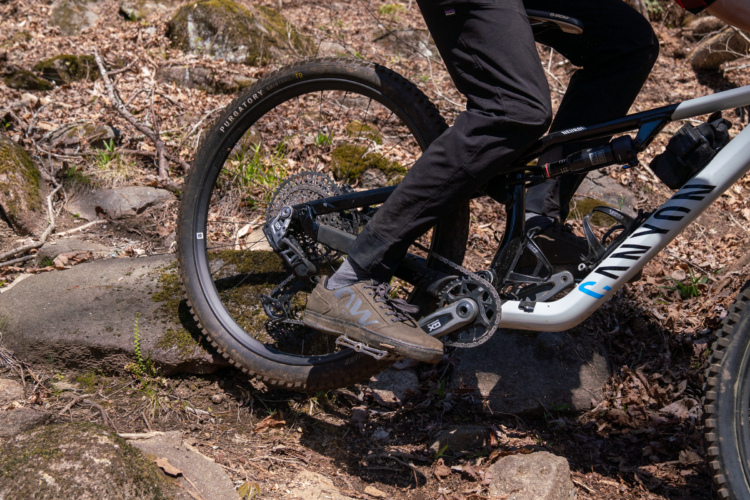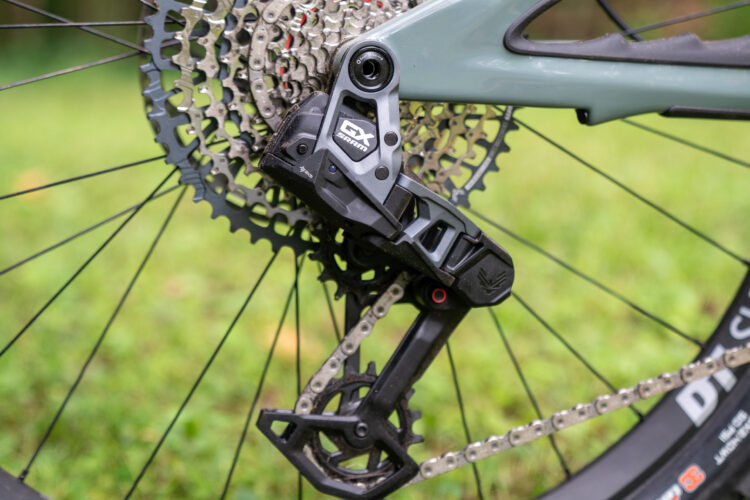
From the moment the first SRAM Eagle Transmission wireless electronic drivetrains were announced in 2023, mountain bikers wanted to know: when would a less expensive group become available? The question was never if SRAM would produce a cheaper groupset; after all, the brand has followed a similar pattern time and again, starting at the top end with a product and methodically releasing heavier, but less expensive, versions.
SRAM S1000 Eagle Transmission is the latest addition to the brand’s wireless drivetrain group, and also the least expensive. The catch: it’s OEM-only, meaning the only way to get the groupset is to buy a bike with the parts attached. Actually, that’s not entirely true, as I found in my research. I’ve been testing a bike with the SRAM S1000 Eagle Transmission drivetrain for a couple of months now, and here’s what you need to know.
Dedicated S1000 components
The derailleur and crankset are the only pieces of the SRAM S1000 Eagle Transmission with the S1000 branding on them, and both are only available as a part of a complete bike build. There aren’t a lot of brands speccing S1000 Transmission drivetrains yet, though notable early adopters include Specialized and Norco.

SRAM S1000 Eagle Transmission derailleur
The S1000 derailleur weighs almost exactly the same as the XO Eagle Transmission derailleur, and almost 20g less than the GX (see weight table below). The S1000 features the same top-loading battery design as the GX derailleur, which seems more secure than the battery arrangement used on the XO. Based on the specs and my experience with all three versions, the S1000 Transmission derailleur would be my choice. It has worked flawlessly during my testing, gets excellent battery life, and has proven to be just as durable as the other, higher-end derailleurs.
According to the SRAM Eagle Transmission service documentation, the skid plates and outer parallelogram links are the same for GX and S1000 derailleurs, aside from the color finishes.

SRAM S1000 Eagle Transmission crankset
The S1000 crankset, like the derailleur, features an all-black finish that I prefer over the two-tone gray and black finish on the GX group components. The crank arms are shaped similarly to the ones on the GX set, and overall the S1000 crankset weighs about 15g more. Bike brands can spec the S1000 crankset in 165, 170, and 175mm lengths and with either a 30T, 32T, or 34T chainring. Mine is set up with a 32T chainring and 170mm crank arms.


The same XO and GX integrated bashguard bits are included with the S1000 crankset. My test bike came with just one set of bits installed on the trailing side of the crank arm, though the Specialized website shows the guard on the leading side. I like the idea of running just one of the bashguards to save some weight while still offering some protection, though to me, it makes more sense to place a single guard on the leading edge. (The SRAM website has a photo of a single guard installed on the trailing edge, just like my test bike.)
| Eagle Transmission weights | XO | GX | S1000 |
|---|---|---|---|
| Cassette | 378.3g | 443g | 558.5g |
| Chain* | 262.5g | 262.1g | 266.3g |
| Derailleur | 471.4g | 489.1g | 471.6g |
| Crank (drive side)** | 304.2g | 410g | 419.4g |
| Crank (non-drive) | 319.7g | 323.8g | 329.3g |
| Remote | 48.8g | 51.1g | 45g |
| TOTAL | 1784.9g | 1979.1g | 2090.1g |



A cheaper and backward-compatible cassette
As a part of the S1000 Transmission group, SRAM provides the XS 1270 cassette. It looks similar to the XS 1275 cassette I tested as a part of the GX Transmission group last year, with a black-plated first gear. Curiously, SRAM photos show a black finish on cogs one through three, and not just the first cog like the one I tested. Anyone can buy the XS 1270 cassette apart from S1000, and priced at $215, it costs $35 less than the GX-spec XS 1275. So, if you’re putting together your own Eagle Transmission group, choosing this cassette could be a way to reduce the price of a GX group by a few bucks. Of course, there is a weight penalty involved; the XS 1270 cassette weighs 100g+ more than the XS 1275.

Also, take note: the XS 1270 cassette works with splined 8, 9, 10 speed driver bodies, unlike all the other Transmission cassettes which require an XD driver body. The driver body spec on the cheaper XS 1270 is similar to the brand’s lowest-level 12-speed (non-Transmission) cassette, SX Eagle. However, this is the first SRAM cassette to fit 8, 9, 10 speed driver bodies that has a 10T cog; the SX only goes down to 11T. It seems SRAM found a way to fit a 10T cog with the old standard after all.
Another unique feature to the XS 1270 cassette is a replaceable gear cluster for gears 8-12 as you can see in the photos above. While the GX-level cassette utilizes a two-piece design separating gears 9-12, this is a four-piece design we haven’t seen before. In theory, this makes replacing a damaged or worn portion of the cassette possible, though availability could be a challenge. Unlike most splined cassettes, the lock ring on the XS 1270 is captured and can’t be removed, just like on XD-driven cassettes.


AXS Pod controller and chain
The AXS Pod controller specced with the S1000 bike I’m testing appears to be almost identical to the one that was included with my GX Eagle Transmission group. Somehow, this one weighs 5g less than the GX and XO Pod controllers I weighed last year, so maybe the mounts are a little different.
Over the summer I shared a one-year update on my GX Eagle Transmission review, and I’ve got another update to share regarding the AXS Pod. A few weeks ago, I suffered a crash, and after dusting myself off and continuing on, I found that one of the rubber button covers was ripped off the controller (above, right). Without the cover, the button is tiny and difficult to press. I’m a little surprised the cover came off so easily, and also frustrated that replacement pads for the AXS Pod controller aren’t easier to find online.

As for the chain, S1000 comes with the GX Eagle Transmission chain. Priced at $50, a GX T-type flattop chain isn’t that pricey, so it’s not surprising SRAM didn’t bother to invent a cheaper T-type chain.
How does S1000 perform?
In a word: similarly. I was going to say flawlessly, and that’s mostly true, but no drivetrain is perfect given the nexus of user error, improper installation, an imperfect design, damaged parts, or all of the above. SRAM S1000 Eagle Transmission performs every bit as well as the GX Transmission drivetrain I’ve been running for over a year, despite some hard riding and serious abuse.
Like the other Transmission derailleurs, the S1000 munches through sticks and brushes off rock strikes with ease. Shifts are crisp and consistent and responsive enough for all but the most rapid last-second gear changes.

Is S1000 Eagle Transmission a good value?
When it comes to bike components, value is the ratio of performance to price. While the performance side of the S1000 is quite good, price is harder to pin down since there isn’t an MSRP. Looking at the Specialized Stumpjumper, the Comp build with S1000 is priced $1,000 less than the Expert build with GX Transmission. But that’s not an apples-to-apples comparison, since the Expert build also has upgraded suspension components.
Norco Optic builds with S1000 are even more difficult to compare. The carbon 2025 Optic C2 MX with S1000 is $6,999 compared to $5,499 for the aluminum Optic A1 with GX Eagle Transmission.
My guess is S1000 might save bike buyers a few hundred dollars compared with a bike with GX Eagle Transmission, given that the two drivetrains share some, but not all, the same parts. Plus there could be additional savings that come with speccing a less expensive rear wheel with an 8, 9, 10 speed driver body hub. It’s probably not a huge difference, but that could be all that’s needed to move a bike build into a lower price bracket. And with similar performance to GX (and an improved aesthetic, IMO) I’ll gladly take the cost savings, even if they are minimal.
One interesting takeaway is that the less expensive S1000 Eagle group actually boasts some minor improvements over components in pricier Transmission groups, notably the derailleur’s improved battery configuration and apparent weight savings over GX. Early adopters and those with the deepest pockets get the latest and greatest, but clearly, good things also come to those who wait.




















0 Comments